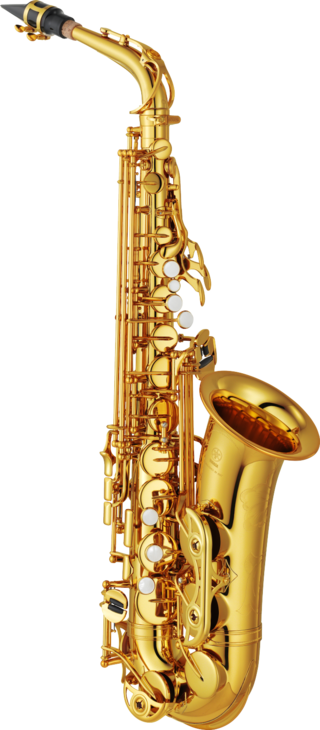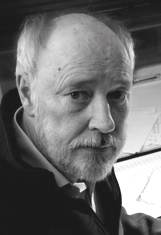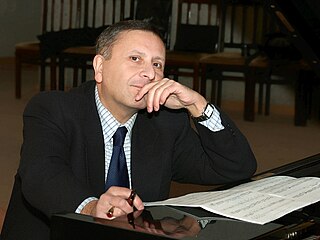
The saxophone is a type of single-reed woodwind instrument with a conical body, usually made of brass. As with all single-reed instruments, sound is produced when a reed on a mouthpiece vibrates to produce a sound wave inside the instrument's body. The pitch is controlled by opening and closing holes in the body to change the effective length of the tube. The holes are closed by leather pads attached to keys operated by the player. Saxophones are made in various sizes and are almost always treated as transposing instruments. Saxophone players are called saxophonists.
Marcel Mule was a French classical saxophonist. He was known worldwide as one of the great classical saxophonists, and many pieces were written for him, premiered by him, and arranged by him. Many of these pieces have become staples in the classical saxophone repertoire. He is considered to be the founder of the French Saxophone School and the most representative saxophone soloist of his time, being a fundamental figure in the development of the instrument.

The alto saxophone is a member of the saxophone family of woodwind instruments. Saxophones were invented by Belgian instrument designer Adolphe Sax in the 1840s and patented in 1846. The alto saxophone is pitched in E♭, smaller than the B♭ tenor but larger than the B♭ soprano. It is the most common saxophone and is used in popular music, concert bands, chamber music, solo repertoire, military bands, marching bands, pep bands, and jazz.
Frederick L. Hemke, DMA(néFred LeRoy Hemke Jr.; July 11, 1935 – April 17, 2019) was an American virtuoso classical saxophonist and influential professor of saxophone at Northwestern University. Hemke helped to increase the popularity of classical saxophone, particularly among leading American composers. He contributed to raise the recognition of the classical saxophone in solo, chamber, and major orchestral repertoire throughout the world. For half a century, from 1962 to 2012, Hemke was a full-time faculty music educator at Northwestern University's Bienen School of Music. In 2002, Hemke was named Associate Dean Emeritus of the School of Music. Hemke retired from Northwestern University in 2012. From the start of his career in the early 1960s, building on the achievements of earlier influential American teachers of classical saxophone — including those of Larry Teal, Joseph Allard, Cecil Leeson, Sigurd Raschèr, and Vincent Abato — Hemke helped build American saxophone repertoire through composers that included Muczynski, Creston, Stein, Heiden, and Karlins. Journalist and author Michael Segell, in his 2005 book, The Devil's Horn, called Hemke "The Dean of Saxophone Education in America." Hemke died on April 17, 2019.
Walter Sinclair Hartley was an American composer of contemporary classical music.

Anders Erik Birger Eliasson was a Swedish composer.

Paul Brodie, was a Canadian saxophonist, pupil of Marcel Mule. In 1994, he was made an Officer of the Order of Canada, Canada's highest civilian honour, for having "shown true mastery of his art through his ability to reach all ages with his music".
Bernhard Heiden was a German and American composer and music teacher, who studied under and was heavily influenced by Paul Hindemith. Bernhard Heiden, the son of Ernst Levi and Martha (Heiden-Heimer) was originally named Bernhard Levi, but he later changed his name.
Jindřich Feld was a Czech composer of classical music.
(Guillaume) Guy Lacour was a French composer of classical music, and a tenor saxophonist.

Kenneth Tse 謝德驥 is a Chinese American classical saxophonist. Tse was mainly self-taught as a youth until he met world-renowned saxophone artist and pedagogue Eugene Rousseau in 1989. He then studied at the Indiana University School of Music with Rousseau from 1993 to 1998, where he received his BM, MM, and Artist Diploma. Rousseau has called him "a brilliant saxophonist, worthy of any stage in the world." Tse earned a doctorate degree at the University of Illinois Urbana-Champaign studying under saxophonist Debra Richtmeyer.
The Concerto in E flat major for alto saxophone and string orchestra, Op. 109, was written by Alexander Glazunov in 1934. The piece lasts about fourteen minutes and is played without pause. It is deeply rooted in Romanticism, and has entered the standard saxophone repertoire.

Vartan Adjemian is an Armenian composer of orchestral, operatic, and chamber music whose works have been performed worldwide.
Frederick A. Fox was an American composer and former music educator specializing in contemporary classical music.
Marcel Wengler is a Luxembourg composer and conductor. From 1972–1997, he headed the Conservatoire de Luxembourg. Since 2000, he has been director of the Luxembourg Music Information Centre. His compositions include symphonies, concertos, chamber music and musicals.
Daniel Deffayet was a French classical saxophonist. He was the professor of saxophone at the Conservatoire de Paris where he succeeded Marcel Mule after Mule's retirement in 1968. He held this position until 1988.
François Daneels was an internationally renowned virtuoso classical saxophonist, a prolific composer, and music educator from Belgium. From 1954 to 1981, Daneels was professor of saxophone at his alma mater, the Royal Conservatory of Brussels.
David DeBoor Canfield is an American composer of classical music.

Fantasia for saxophone, three horns, and strings, W. 490, is a concertante work in three movements by the Brazilian composer Heitor Villa-Lobos, written in 1948. A performance of it lasts approximately ten minutes.







